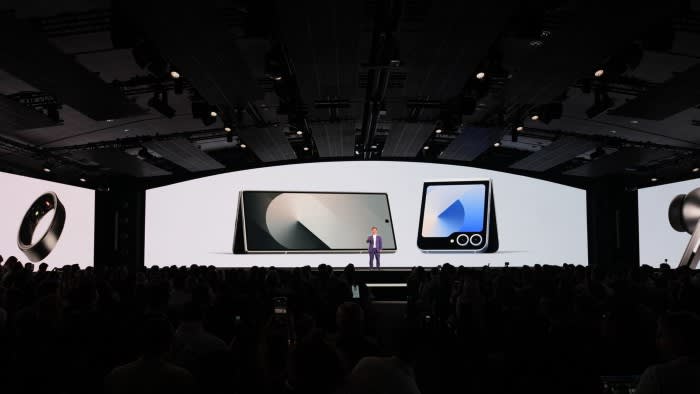Samsung Electronics is grappling with a deepening labor crisis that is complicating efforts to catch up with rivals in a fast-growing market for semiconductors used in artificial intelligence systems.
The South Korean tech giant delighted investors earlier this month by forecasting that its second-quarter operating profit would rise about 1,500 percent from the same period a year earlier as the global memory market recovers from a long slump.
But the better-than-expected outlook comes amid growing worker unrest and a slowdown in chip production, leaving Samsung lagging behind rivals in areas seen as crucial for future growth. Samsung shares have risen about 7.5% this year, compared with SK Hynix, a smaller domestic rival, which has risen 65%.
Samsung has lagged SK Hynix and U.S. chipmaker Micron in developing high-bandwidth memory (HBM) chips, a key component of AI systems, and has yet to pass the tests needed to qualify as an HBM supplier to industry leader Nvidia.
“This is very worrying for a company that has historically been a leader in memory manufacturing,” said Myron Shi, an analyst at semiconductor consultancy Semianalysis. “HBM is a very high-margin product, so Samsung is missing out on a big opportunity.”
Samsung also failed to make a dent in TSMC’s dominance in the global foundry business, the market for contract manufacturing of processor chips, despite optimism that big customers would seek to reduce their reliance on the Taiwanese semiconductor giant amid rising geopolitical risks.
“Customers want a second foundry option, but their top priority is ensuring technology quality and a stable source of supply, and Samsung Foundry has not been able to deliver on that,” Xie said.
In May, Samsung Chairman Lee Jae-yong suddenly appointed industry veteran Chung Yong-hyun as the new head of Samsung Electronics’ semiconductor division, with Chung promising to “refresh the atmosphere both domestically and internationally” to address the company’s “semiconductor crisis.”
But a Samsung chip engineer, speaking on condition of anonymity, told the Financial Times that he had not seen any major changes since the change in leadership.
“At HBM we are lagging behind SK Hynix, and at the foundry we can’t catch up with TSMC, so the mood within the company is gloomy,” the engineer said.
“They feel they are treated worse than their colleagues at SK Hynix and are dissatisfied with their salaries in general,” they added. “Many are considering leaving the company to join a competitor.”
Workers’ growing discontent was on full display last Monday, when an estimated 6,500 members of the Samsung Electronics National Union, whose membership has grown from 10,000 to more than 30,000 in a year, launched an unprecedented three-day strike.

The company unveiled its latest foldable smartphone with enhanced AI capabilities on Wednesday but is facing intense pressure from Apple and low-cost Chinese rivals in mobile, who also threaten to eat into its market share in displays and home appliances.
“Employee morale is low and they are depressed by the decline in financial compensation,” said a researcher at Samsung’s smartphone division, who spoke on condition of anonymity. “Employees feel helpless as management appears to have lost their sense of direction.”
“I’ve always been used to sales growth since I was an office worker, but this is the first time we’ve seen growth slow down,” added a Samsung electronics salesman, who also asked not to be named. “People on my team are feeling the pinch.”
Samsung denied NSEU’s claim that the three-day strike had disrupted semiconductor production, but the union said on Wednesday it would continue the “indefinite strike” targeting production lines, including those used to make HBM chips.
“Management has no intention of engaging in dialogue,” the union said in a statement. “Disruption to production lines is evident and the company will regret this decision.”
Samsung said in a statement to the Financial Times that it “remains committed to negotiating in good faith with the union” but declined to comment on the personnel issue. But analysts said the strike will complicate efforts to regain ground after falling behind SK Hynix in the HBM race.
The two rivals are now in fierce competition for limited South Korean engineering talent, according to a Samsung investor, though both declined to comment on the talent battle.
Samsung announced a cross-functional team last week to work on HBM development, which should eventually close the technology gap with SK Hynix as the industry moves to the next generation of HBM chips, according to Nomura analyst CW Chung.
“Once you get the strategy wrong and develop the wrong chip, the ripple effects last for about three years,” Chung said, noting that the broader upward cycle in memory will continue to drive the company’s profitability during that time. “But it looks like the worst is already over.”
Samsung argues that as the only company with capabilities in cutting-edge foundries and memory chips, as well as next-generation “advanced packaging” technology, it is well positioned to compete against the burgeoning alliance between SK Hynix and TSMC, which are collaborating closely on next-generation AI chips.
“Our commitment to technological advancements and scale of investment has been and will remain core to our success,” the company said. “We are confident and excited about the opportunity to successfully navigate the current situation and solidify our leadership position.”
But Semianalysis’s Xie said, “If Samsung isn’t the best in any of the above aspects, then being a one-stop shop has little value to a chip design company.”
“Given that Samsung has experienced a decline in technological prowess in multiple areas of its business, the issues appear to stem from the company’s leadership and culture,” he added. “A cultural reset may be long and painful, but it may be the best thing for the company in the long run.”


